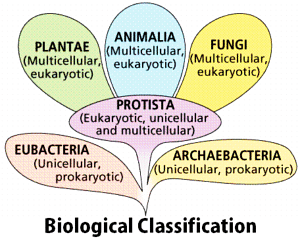Phenetic classification is based on:
- The ancestral lineage of existing organisms
- Observable characteristics of existing organisms
- Dendrograms based on DNA characteristics
- Sexual characteristics
The Correct Option is B
Solution and Explanation
Phenetic classification, also known as phenetics, is based on observable characteristics or phenotypic traits of existing organisms. It involves grouping organisms together based on overall similarity in characteristics without necessarily considering their evolutionary history or ancestry.
So, the correct option is (B): Observable characteristics of existing organisms
Top Questions on Biological Classification
Each of the following characteristics represents a Kingdom proposed by Whittaker. Arrange the following in increasing order of complexity of body organization.
A. Multicellular heterotrophs with cell wall made of chitin.
B. Heterotrophs with tissue/organ/organ system level of body organization.
C. Prokaryotes with cell wall made of polysaccharides and amino acids.
D. Eukaryotic autotrophs with tissue/organ level of body organization.
E. Eukaryotes with cellular body organization.
Choose the correct answer from the options given below:- NEET (UG) - 2025
- Biology
- Biological Classification
- Which of the following organisms is correctly matched with its kingdom?
- CUET (UG) - 2025
- Biology
- Biological Classification
- The difference in characters within very closely related groups of organisms are called:
- TS POLYCET - 2025
- Biology
- Biological Classification
- Which kingdom is included in all kingdom system classifications?
- AIIMS BSc Nursing - 2024
- Biology
- Biological Classification
- Match List I with List II
List I List II A Typhoid I Fungus B Leishmaniasis II Nematode C Ringworm III Protozoa D Filariasis IV Bacteria
Choose the correct answer from the options given below:- NEET (UG) - 2024
- Biology
- Biological Classification
Questions Asked in NEET exam
- A microscope has an objective of focal length \(f_o = 2\) cm and an eyepiece of focal length \(f_e = 4\) cm. The tube length of the microscope is \(L = 40\) cm. If the distance of distinct vision of eye is \(D = 25\) cm, the magnification in the microscope is:
- NEET (UG) - 2025
- Optical Instruments
- Which one of the following is an example of ex-situ conservation?
- NEET (UG) - 2025
- Ex-Situ Conservation
- Which one of the following compounds can exist as cis-trans isomers?
- NEET (UG) - 2025
- Organic Chemistry
- Who proposed that the genetic code for amino acids should be made up of three nucleotides?
- NEET (UG) - 2025
- Molecular Biology
- An electron (mass \(9 \times 10^{-31}\) kg and charge \(1.6 \times 10^{-19}\) C) moving with speed \(c/100\) (\(c\) = speed of light) is injected into a magnetic field of magnitude \(9 \times 10^{-4}\) T perpendicular to its direction of motion. We wish to apply a uniform electric field \( \vec{E} \) together with the magnetic field so that the electron does not deflect from its path. (speed of light \(c = 3 \times 10^8\) m/s):
- NEET (UG) - 2025
- Electric Field
Concepts Used:
Biological Classification
The process of grouping living organisms into categories is called biological classification. The most modern 5-kingdom classification was put ahead by an eminent scientist R.H.Whittaker. The five-kingdom classification is based on the criteria like cell structure, mode of nutrition, body form, and reproduction. One of the most important characteristics of this system is that it follows the evolutionary sequence of living organisms. The organisms are classified into distinct taxa or levels like Kingdom, Phylum, Division, Class, Order, Family, Genus, and Species. The 5 kingdoms are as follows:
